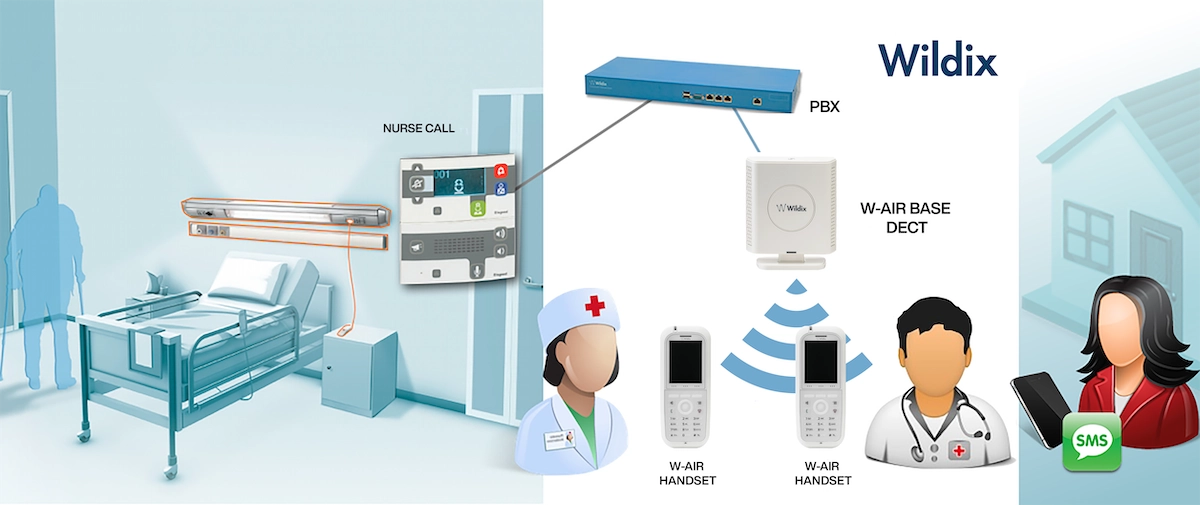
Unified communication as a service (UCaaS) has revolutionized the way we work by boosting productivity and offering a level of flexibility that was previously unimaginable. But four, nearly five, years on from the pandemic the benefits of the unified communications revolution still haven’t reached the majority of frontline workers, especially in healthcare. While hybrid working patterns aren’t compatible with frontline roles in hospitals, nursing homes and other healthcare settings, caregivers still have much to gain from streamlined communications between their patients and colleagues. Their needs and the reality of communication in healthcare are just different.
The Role of Communication Technology in Healthcare
Far from being cut off from communications, frontline healthcare professionals often have to sift through a large amount of information from multiple systems. This is especially true of alarms and call systems, which traditionally rely on audible notifications that can be heard across the ward, causing alarm fatigue in caregivers and affecting patients’ ability to sleep, relax and heal.
But beyond alarms designed to safeguard patient health, frontline workers still have to communicate with colleagues on the ward and at the reception desk, notify patients’ relatives and liaise with other medical facilities. In some situations, this is done over different channels or from traditional desk phones located at a distance from their patients on the floor.
In fact, communication technology in healthcare often includes:
- Nurse call systems
- Environmental alarms
- Wearable IoT devices
- Worker alarms
- Traditional phone systems
- Telemedicine
All of these often use different platforms or signaling technologies, making it easy for staff to miss a vital notification as they are all delivered differently. With Wildix’s unified communication solutions, however, hospital communication can finally be simplified, bringing all these different communication solutions together into one single system.
How does it work? Let’s take a look at each of these different technologies to see how Wildix unifies and simplifies communications for healthcare.

Wired or wireless nurse call systems
Designed to quickly connect nurses and care staff to patients in need, wired or wireless nurse call systems use buttons, bracelets, beacons, pull cords or even two-way communication panels that send notifications to nurses via door lights, call panels, pagers or phones. These solutions are invaluable for ensuring patients can call for help whenever they’re in trouble or need to ask a question. Their efficiency, however, comes down to how quickly the notification can reach a nurse and be assessed.
To streamline these notifications and ensure that they always reach the right person, Wildix offers a nurse call integration with our line of DECT handsets, W‑AIR. With models that offer an antibacterial coating (W‑AIR Med) and anti-sparking precautions (W‑AIR LifeSaver EX), the W‑AIR handsets are robust and safe enough to be used for hospital communication while also offering high-quality wireless calls throughout healthcare facilities. More importantly, the Wildix integration means that all notifications from the nurse call system go to the W‑AIR handsets, ensuring that care staff are alerted immediately wherever they are on site.
And since Wildix hardware and software are secure by design, all two-way communication is encrypted so patients can speak to nurses via a wireless nurse call system or regular phone call knowing that their conversation is confidential and the line is secure. Caregivers need to carry one phone to get all of their notifications as well as internal and external calls, boosting their efficiency and response time.
Environmental alarms
Just like nurse call systems, environmental alarms are another interesting piece of communication technology in healthcare that sends notifications if it detects extreme heat, fire, carbon monoxide, flooding or other unusual incidents. Traditionally, most of these alarms are loud and designed to be heard by everyone in the building — in the event of a fire you want everyone to get out as quickly as possible. But there are times when the noise can become too much of a burden or may not be audible in certain parts of the building, especially if the alert is specific to one room or one area of the medical facility.
In these cases, Wildix can also integrate environmental alarms with the W‑AIR handsets, ensuring that nurses and healthcare professionals know exactly when and where an emergency is happening. The integration allows hospitals, care homes and other care settings to set different alarm levels with colors and unique ringtones so they can know at a glance if the alarm is coming from a smoke detector, thermostat or a wireless nurse call system. The message shown on the screen can give even more detail, letting staff know what area or room is affected. This use of communication technology in healthcare leads not only to quicker responses but also makes it easier for nurses and other frontline medical workers to prioritize which alarm to respond to first, ensuring that all patients get the best care possible.
Wearable IoT devices
Yet another source of alarms and notifications is wearable IoT devices that monitor patients’ vitals and other health metrics. These devices, which often are as small as a wristband, give patients the freedom to move around while also sending continuous updates and alerts regarding patients’ health.
This type of communication in healthcare ensures that healthcare professionals are up-to-date on a patient’s condition; however, the effectiveness of the different alerts and alarms depends entirely on how they’re delivered. Luckily, just like the other types of communication technology in healthcare we’ve already covered, most of these wearable IoT devices can easily integrate with the Wildix system, thanks to our open APIs and full support for ESPA protocol.
And the benefits go beyond streamlining alerts by sending them to a W‑AIR handset. Managers also have access to a call and alarm log that displays the details of each event including who responded and the response time, making it easy to track how incidents are handled within the team and identify areas of improvement.
Worker alarms
While we often think about patient safety, caregivers are also potentially at risk, especially when they are working on their own. As a result, it’s just as important to have a quick way for them to call for help as it is to offer comprehensive nurse call systems to patients.
Worker alarms set into handsets are particularly useful for this, as they are portable and available at all times. Wildix’s W‑AIR Med handset, for example, offers a panic button alarm while both the LifeSaver and LifeSaver EX models have running, man-down, standing, lone worker and pull-cord alarms, allowing nurses and healthcare assistants to quickly call for help whenever they’re in distress. The system also monitors the location of the alert and includes it in the notification, ensuring help can find them wherever they are. And, of course, caregivers can use the handset to make a call to ask for specific help or support, when needed.
Traditional phone systems
Providing communications for healthcare isn’t all about alarm management — though cutting down on alarm fatigue is an integral part of optimizing hospital communication. Patients, relatives, staff and other medical facilities still rely on phones, two-way call systems and text messaging to stay informed. And often the phone system is completely separate from the other types of communication technology in healthcare, making it easy to miss calls while on rounds — especially if they only come through on a desk phone.
With Wildix, you have full telephony features, allowing you to set up a phone menu, or IVR, to manage incoming calls, transfer calls to caregiver’s handsets and even send SMS messages to patients through the web application for appointment reminders. Even better, staff members can switch between multiple devices effortlessly, allowing them to access the same features, including an integrated phonebook, whether they’re calling from a desk phone, handset, smartphone or web browser. There’s even a presence indicator synced across all devices, ensuring colleagues always know who is available to take a call.
Telemedicine
Another rising type of communication in hospital settings is telemedicine, or virtual appointments, which use video conferencing software to carry out different types of patient meetings in a quick and convenient format. The virtual appointments are also helpful as they reduce staff members’ potential exposure to viruses and allow them to see more patients in a day than they could with traditional appointments.
However, many hospitals and other healthcare settings use a video conferencing service that’s separate from their communication technology in healthcare solutions, forcing them to learn another system and risk being interrupted by incoming calls. With Wildix communication solutions, video conferencing comes included and works on the same intuitive browser-based platform as calls and chat. This unified communication approach means it’s easy to use and users don’t have to worry about unwanted interruptions as their presence status is shared regardless if they’re on a call or in a virtual meeting.
Additionally, Wildix integrates with Microsoft 365 and Google Calendars, allowing you to create booking pages that patients or their relatives can use to easily schedule an appointment without having to call the office. In fact, you can go beyond digital bookings by adding Wildix’s website widget to your website, allowing patients and relatives to start a chat, audio call or video conference without downloading any programs. All they need to do is click on the widget and voilà, they have a direct line of communication to book an appointment or even launch their online consultation.
Wildix: Unifying Communication in Hospital and Healthcare Settings
Communication technology in healthcare involves many different systems, devices and notifications that all play an important role in both safeguarding patient and employee safety and improving patient services. But to enjoy the full benefits of all these different technologies, they must be integrated into one communication system, otherwise calls and notifications can be missed and caregivers can easily suffer from alarm fatigue and feel disconnected from the wider business.
To combat this, Wildix offers a unified healthcare communication experience, connecting receptionists, frontline healthcare workers, patients, relatives and even call centers through one system, removing communication barriers and reducing alarm burden by streamlining and prioritizing notifications. And since the system is flexible enough to integrate with nearly any system, there’s no need to overhaul your entire communication ecosystem. Instead, you can integrate your preferred systems and devices, or drop redundant services, to create the best solution for your healthcare setting.
In short, regardless of the provider you choose, don’t wait to unify your healthcare communications. Because if you move your frontline workers from the sidelines to the center of your communications, you’ll see not only improved productivity and patient satisfaction but employee retention and engagement as well.
Enjoyed this article? Check out our previous article on the dangers of smartphones in healthcare environments.
For more insights on healthcare communications, subscribe to receive our magazine for free!